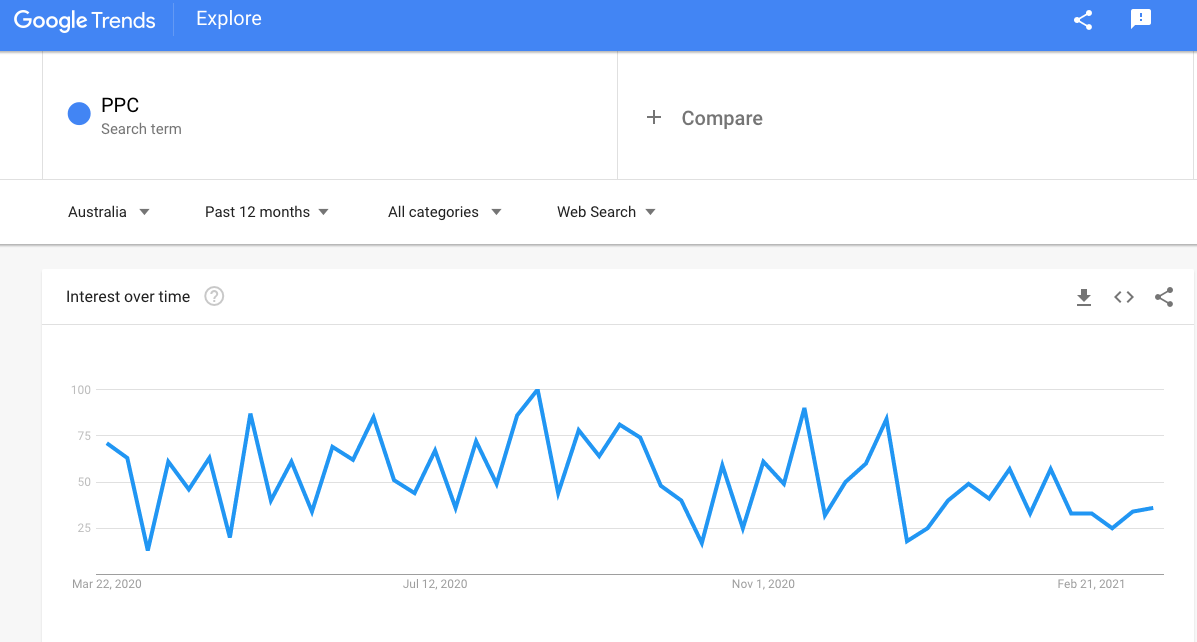Seasonal search engine marketing is your ticket to getting the most out of your SEM campaigns.
This is because consumer trends and needs vary throughout the year, so varying your marketing efforts is a smart way to maximise your website traffic and conversions.
And even though Autumn doesn’t have the festivity of summer or the ‘fresh start’ feel of Spring, there are many ways you can optimise your autumnal SEM.
This is your toolkit for optimising your search engine marketing for Autumn, so there’s no ‘off-season’ for your digital efforts.

Identify seasonal keywords to target.
Aside from the obvious gift-related searches in the lead-up to Christmas and exercise-related search in January, it’s not always easy to know which keywords are trending or, specifically, when they are trending.
Google Trends will help you to discover the peaks and troughs of various keywords throughout the year. To begin, type in all of your usual keywords to see which ones are trending in Autumn. You can also type in associated keywords to see if there are any opportunities that you haven’t targeted before.
Once you have discovered trending keywords, you can invest more into those terms and phrases to capture your audience at the time when they want your products or services the most. You might increase your bidding, or increase your spending cap for the month.
For example, we can see that the search term ‘PPC’ peaked across the week of May 10-16 in Australia in 2020. With this information, we might set a higher budget for spending on keywords such as ‘PPC’ and ‘pay-per-click’.
Don’t forget that Google Trends also offers a state and territory option, so you can research keyword peaks specific to your area.

Use Google Search Console.
Another of Google’s nifty tools is the Search Console.
This tool allows you to see which pages on your website are gaining the most engagement at any one point. You can search anything over the last 16 months, so taking a look at your data throughout Autumn, and looking at information from last Autumn, should give you a good idea which of your website pages are most ‘in demand’ during the season.
Again, you can use this information to influence your paid ad management. You can invest more into each click, set a higher limit for the campaign overall (therefore allowing more clicks before you reach that cap), or invest in a wider set of keywords that can lead back to your in-demand landing pages.
Do a Spring clean – in Autumn.
So much of search engine marketing is asking ourselves what we can do better and what we can do next, that we forget to go back and check up on what we have already done. In some cases, old content may even be dragging you down, which is why regular spring cleaning is in order.
That is, of course, checking and fixing broken links.
Links on your website that no longer link to live pages can be hugely frustrating for your readers, but it can also negatively impact search engine results if Google crawls your page and finds dead ends.
One study of US Fortune 1000 companies in 2018 found a massive number of broken links. Even amongst the world’s most profitable and well-known brands, there were more than 13,000 broken links across just 135 websites. For something that is so easily fixed, it is incredible just how many websites let this bit of housekeeping go unchecked.
Therefore, use a broken link checker to uncover those areas, and either remove the hyperlink or update it. This will ensure all the new efforts you make aren’t being held back by old problems.

Know your own products.
Google’s suite of tools offer great insights into industry-wide trends and customer behaviour, but they don’t know your company and products quite like you do (yet, at least).
Take a look into last year’s sales records, and all the years you have data for. Speak to your sales staff and managers and collate the information to give yourself a picture of what to expect for the upcoming season. You could even run a survey on your social media pages or ask for feedback via a newsletter to get a better feel for what your customers think and need.
You might find the inspiration to build a new landing page, target a specific set of keywords or invest in Google AdWords for a specific product.
Switch off irrelevant Google AdWords.
Good Google Ads management will start with careful keyword research, grouping terms into ad campaigns and groups.
In the lead-up to Autumn, it pays to review current campaigns to ensure the keywords you’re bidding for will still pay dividends.
For example, a brand selling linen products might find that beach towels and beach towel keywords are in hot demand over the warmer months, but drop dramatically in Autumn. This is the time to temporarily switch off bidding for beach towel keywords – while keeping higher value products such as winter bedding in the spotlight.
If your company has products or services that don’t typically sell well in Autumn, it might pay to invest your PPC dollars elsewhere during the season.
RELATED: What kinds of customers can you target with SEM?
Ensure your seasonal updates are across the board.
Let’s say you have chosen to focus on a particular product that hits the right keywords and historically trends well through Autumn.
If you are pouring your marketing budget into a diverse search engine marketing campaign in Autumn targeting a specific set of keywords, the rest of your materials and website should reflect this focus.
Therefore, incorporate your social media channels, make use of your newsletter, update your calls to action and create a button or other feature on your homepage to showcase the item in question.
This fully integrated focus will help to ensure that customers will see and interact with your chosen messaging at every touch point, ultimately encouraging higher conversions thanks to your initial investment in PPC.
Plan for the lead up, the peak and the aftermath.
Every year, searches for the term ‘bikini’ start increasing with the temperature. After the lows of late Autumn and Winter, consumers start planning their summer swimwear in spring, running the most searches from November through to January, then falling away again in Autumn.
Savvy swimwear companies will segment their search engine marketing efforts for each of these stages. Similarly, you should modify your approach for the lead up, the peak and the aftermath.
For example, that swimwear company might focus their early marketing efforts on highlighting this season’s bikini trends, and introducing new prints and designs. This will create awareness and familiarity of the brand ahead of the peak purchasing season.
During the peak, they might offer special deals or target their keyword strategy on those with a purchase intent. And as bikini interest diminishes in late summer, the brand might shift their marketing focus to end-of-season sales, or even shift their geographic target market to more northern regions of Australia or to those planning to travel during winter.
Keep these phases of seasonality in mind to create a search engine marketing campaign that shifts with your audience’s interest and intent to optimise at every point.
RELATED: SEO vs SEM: what’s the difference when marketing to regional communities?

Focus on long-tail keywords.
Short-tail keywords typically have higher search volumes, yet the specificity of long-tail keywords tends to result in higher click-through rates and conversions. Not to mention, increasingly savvy web searchers know to be more specific with their queries in order to find results that best suit their needs.
In fact, as much as 70% of searches involve long-tail keywords, and long-tail searches convert 2.5 times more frequently than short-tail.
Seasonal long-tail keywords are an excellent way to capture your audience at a specific time of year. Take note of the long-tail opportunities that appear in Google trends and other keyword research tools, even if they aren’t the most prolific in terms of numbers.
This is your opportunity to capture an audience with a specific issue that can be solved with your products or services.
For example, a landscaper, handyman or plumber might want to focus on their seasonal gutter cleaning and repair services over autumn. Instead of simply working on the keywords ‘gutter cleaning’ or ‘gutter overflowing’, they might use long-tail keywords – such as ‘how do you fix overflowing gutters’ or ‘how often should you clean your gutters’ – in their SEM campaign.
Bring in expert help.
Search engine marketing is an excellent way to boost your bottom line at any time of year and there are many ways a smart business owner can implement an SEM strategy to reap the rewards.
However, not everyone has the time or inclination to do the research, explore the tools available and create the content and marketing required to optimise for every season.
In that case, asking the experts may be the best way for you to optimise your SEM for Autumn. SEM offers a comprehensive suite of services from a team of experts who know how to drive leads to your business for every season.
Get on top of your seasonal SEM and get in touch with Yellow Pages today.

